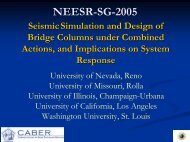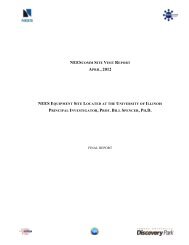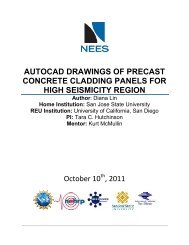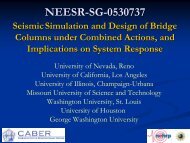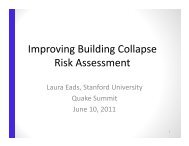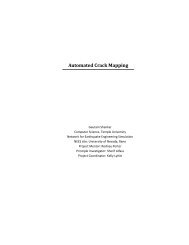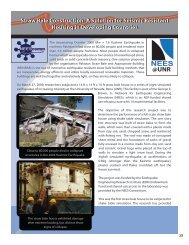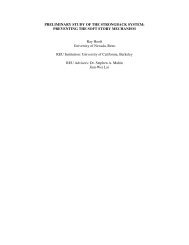TSUNAMI WAVE BREAKING BEHAVIOR ON A REEF WITH A ...
TSUNAMI WAVE BREAKING BEHAVIOR ON A REEF WITH A ...
TSUNAMI WAVE BREAKING BEHAVIOR ON A REEF WITH A ...
You also want an ePaper? Increase the reach of your titles
YUMPU automatically turns print PDFs into web optimized ePapers that Google loves.
4. Results<br />
Since the wave breaking geometry was determined manually using a grid that was of a low resolution,<br />
the measurements could only be made to within 0.25m, giving a maximum error of ±0.125m. Since the<br />
scale of this experiment was on the order of tens of meters, the possible maximum error was not<br />
considered significant. Because a normal digital camera was used, the video only captured the<br />
movement at 30 fps. This could cause a small source of error since the wave breaking point could have<br />
occurred between frames. If the breaking point was between two frames, the difference in the point of<br />
breaking between the frames was no more than 0.125m, again making the error insignificant.<br />
All relationships and graphics were made using Ho’ as the independent variable except for those<br />
relationships being compared to the previous literature. Following the standard method to describe<br />
hydraulic experiments, all variables were turned into ratios.<br />
While the original intent was to use all of the trials in every different experimental setup, it was difficult<br />
to determine the breaking point when the waves were very small (Ho’= 0.05 or 0.1). After calculating<br />
the slope parameter So (Eqn 2), the reason for difficulty was found. Waves with Ho’ ≤0.15 were<br />
considered surging instead of plunging (Table 1), indicating that these waves did not have a defined<br />
breaking point. Consequently, surging waves were not considered in this study. Out of the eight<br />
bedform configurations, three were left out of data analysis due to time constraints. Blank surface trials<br />
were also omitted as they were run after this paper was written. While data from all water levels was<br />
analyzed, only data from water level 20cm is shown in the majority of this report.<br />
4.1 Roughness<br />
The roughness altered the breaking behavior of the waves. The bedforms slowed the waves, causing<br />
them to lose energy and consequently affecting the breaking parameters (Hb, hb, db, dc). The flat reef<br />
bedforms had minimal affect on the breaking parameters however since they were placed beyond the<br />
zone where the waves usually broke. The wave height at breaking (Hb) was significantly lower when the<br />
bedforms were on the slope (Figure 7) and the waves also broke and crashed sooner than when the<br />
roughness was on the reef flat (Figures 8 and 9). Of the different bedform configurations on the slope,<br />
BS2 had the lowest roughness coefficient and therefore was considered the roughest (Table 2). As seen<br />
in Figures 8 and 9, the waves that propagated over BS2 had the smallest breaking and crashing<br />
distances, indicating that the energy had dissipated the most. The difference in roughness in BS1 and<br />
BS3 was very similar, and therefore they behaved almost identically. Since the reef roughness didn’t<br />
affect the breaking behavior significantly, BR3 and BR4 also behaved similarly. The blank trials would<br />
have been a useful addition to this analysis as they would have given insight into exactly how the<br />
bedforms affected the waves.<br />
7






